To my surprise, people seem curious in the gear I use that comprises my sleep system. I’ll be describing my current setup that I’ll be using for the Tour of the Highest Hundred, a two-month bikepacking and peak bagging adventure. Like everything, it’s a constantly evolving kit, that changes depending on weather, seasons, geographic location/environment, and conditions. There’s no One True Sleep System. My own sleep system is constrained by some pretty crazy requirements:
Season
I’ll be out from ~July 15th to ~September 15th, mostly in the Colorado high country and sleeping at an elevation from around 6,000′ above sea level to well, let’s say 12,000′ if I’m feeling frisky. I’m expecting temperatures at night from around 50 degrees F to well below freezing and foul weather including wind, rain, sleet, snow, grauple, and everything in between. Mostly though, I’ll be hoping for clear, calm nights, and the occasional monster thunderstorm. My sleep system has to protect me 100% from precipitation of all the forms listed. Even one night exposed to a freezing rain could be dangerous.
Environment
For the most part, I’ll be sleeping at trailheads of the Centennials, around 6,000′ – 10,000′, well below treeline in the subalpine forest. I’ll have ample opportunity to find enough flat ground to at least put my sleeping bag down. In rarer circumstances, I’ll be camping above treeline, around 12,000′, so I’ll need a system that doesn’t rely on using something like a tree to set up my shelter.
Vibe
For lack of a better term, my sleep system really just needs to keep me sheltered from any weather and to be warm enough – it’s not going to be a basecamp for weeks on end as I lay siege on a mountain, or a place to whoo a ladyfriend – or even to play an extended game of cards well into the night. I need it to be easy to set up and take down without a lot of fuss, and flexible enough to work in different environments. I don’t want to take a lot of time to find the perfect spot – I want to get there, set things up within minutes, throw some food in my mouth, and pass out underneath it.
The Fundamental Parts: Tarp/Bivy/Bag/Pad
My sleep system is comprised of these four parts that, when put together, can keep me relatively comfortable in all the extreme cases I can think of. What’s even better, is that each one is really optional, so I can make decisions on just what I want to set up, given my current circumstances.
Tarp
The tarp’s main job is to provide a simple, waterproof shelter for myself, the rest of my sleep system, and my gear. I need to be able to set it up anywhere, and do so quickly. Everything underneath it should be protected by anything coming down from the sky.
The Ultimate Direction FK Tarp doesn’t come with its own poles. The main structural component that keeps the tarp above your head are two trekking poles you provide. I’ll be bringing along these anyways, so they’ll play double-duty. Any time I’m fastpacking with the tarp, I’ll have my poles with me, so there’s never going to be a decision I have to really make to see if I want to bring poles are not: in almost every instance I will. The tops of those poles fit into pockets that include a cinch, so they should stay put, once in.
This tarp is actually a two-person tarp, so the amount of space below it is actually quite luxurious!
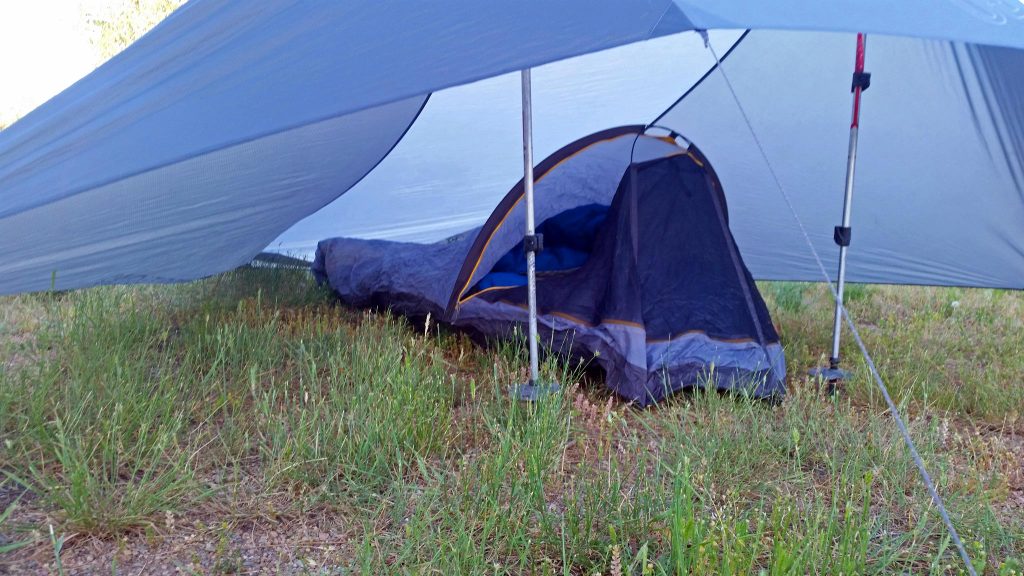
The rest of the tarp is tied down using six tiny stakes. I will say that it is a bit of juggle to put up the tarp as a single person, as you do need a bit of tension in one part of the tarp to set up another part. But with two people, it should be a breeze.
This brings up a good tip though: always try out your gear at least once before taking it with you on any size trip. The first night I used the tarp, night had fallen and it just began to snow – I started putting up the tarp as if it was a system requiring a tree branch to set things up. This tarp doesn’t need that, so I wasted a few minutes for that perfect tree when one wasn’t needed.
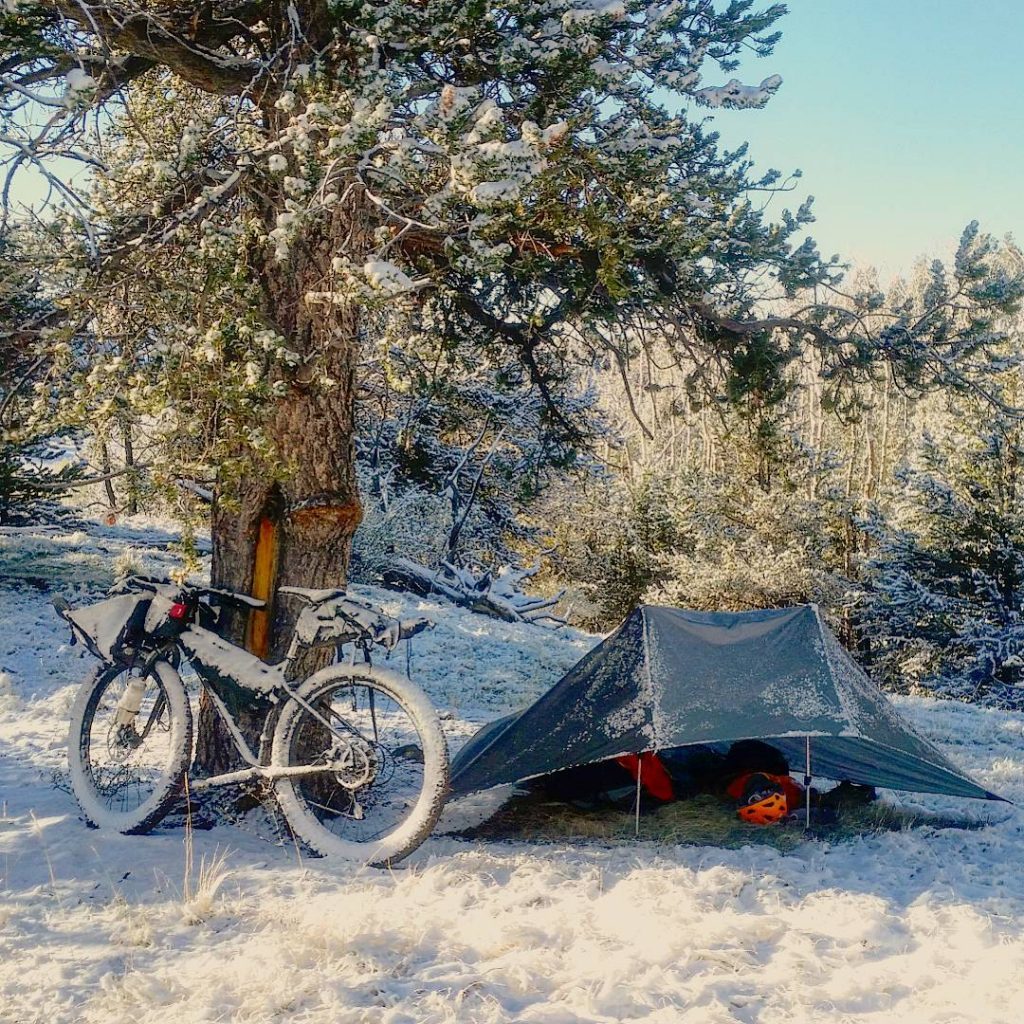
Well, hey there random snow storm!
Once up – it shouldn’t take more than a few minutes, the system is solid, and I never woke up with the tarp collapsing on me, or a tent stake coming out expectantly. I’m pretty happy at my experiences staying underneath it as rain and snow showers passed over me.
For bikepacking where your not necessarily carrying trekking poles, this style of tarp system may not work well for you – or would need some readjustment. Update: Ultimate Direction sells a bikepacking/bike conversion kit, so you can use the tarp without needing poles at all! You could try using random branches in-lieu of trekking poles, or use a system that doesn’t rely on them at all – either by tying parts of the tarp to trees/something elevated, or going the tent route, which would use tent poles.
I myself did my 14er tour using a tarp which was actually a re-purposed two-man tent ground cloth I found at the local sports recyclery for cheap and some guy lines that I would tie to tree trunks, and even sometimes, my bike.
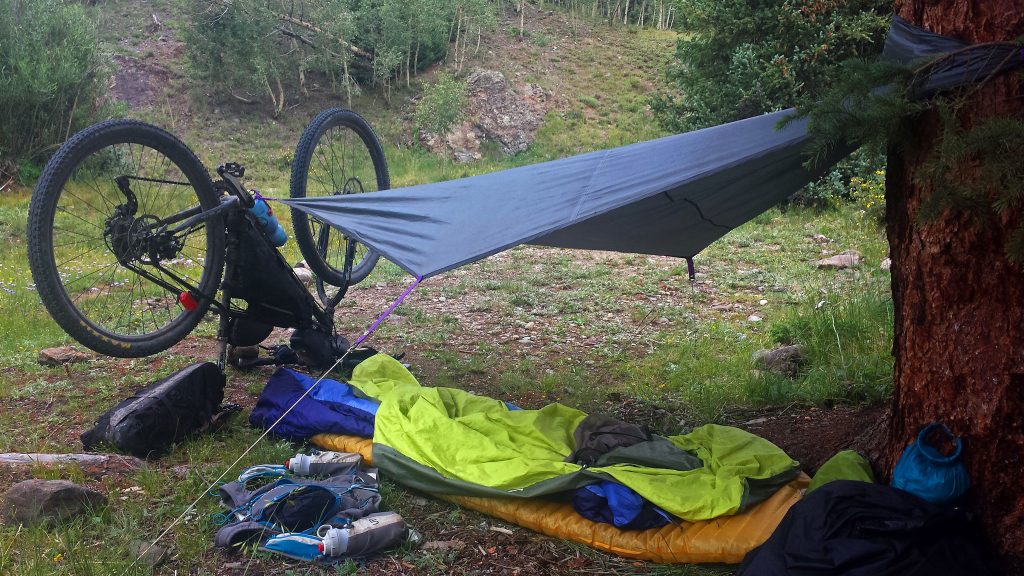
This works, but it does require that you set it up basically somewhere below treeline. The one time I set this up above treeline, I used the info sign of the trailhead for Mount Bierstadt, rather than a tree! It was a miserable, rainy/snowy night, and I was exhausted. Not the best sleep in the world, for sure. You can see in my photo above that this setup isn’t impermeable. Compared to the FK Tarp, the hack groundcloth-as-overhead-tarp just doesn’t reach all the low to the ground. Comparing with what I now have, it’s incredible it worked as well as it did!
I may bring a few accessory chords for guy lines on this trip just for a little flexibility, or to rig up a repair if things go south,
but it’s not on my, “totally critical” list.
Speaking of guy lines, another pro tip: keep these little mofos well-organized or they will knot up, and you will hate yourself as you try to unknot them as the rain starts to fly!
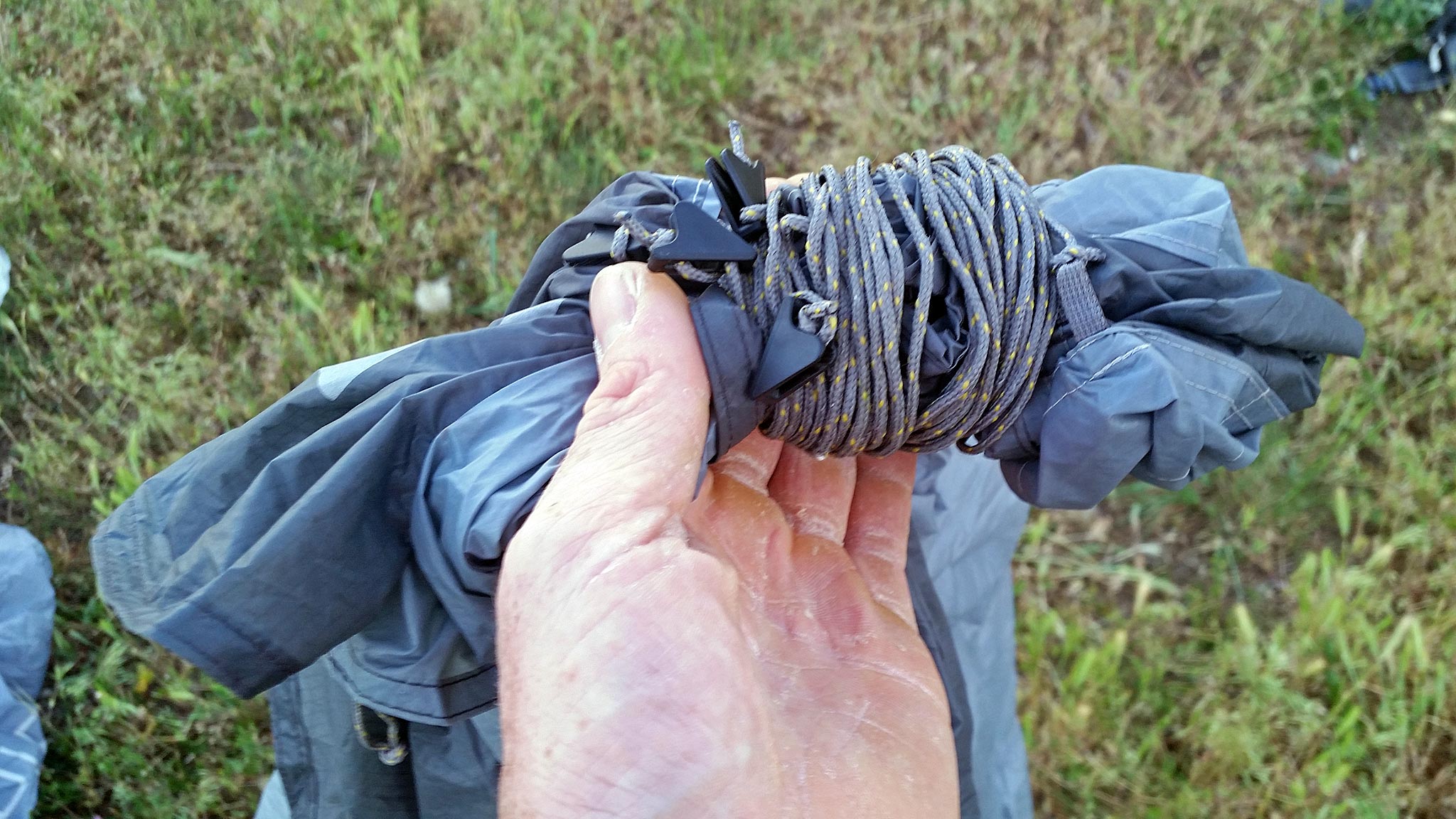
One method is to get all the guy lines together (the FK Tarp has basically four of them), then wrap them in a hunk of the tarp. Once they’re all wrapped up like the photo above, fold the rest of the tarp around them, so they stay in the center. Hopefully, that’ll keep some semblance of stability for when you unbundle everything later.
Bivy
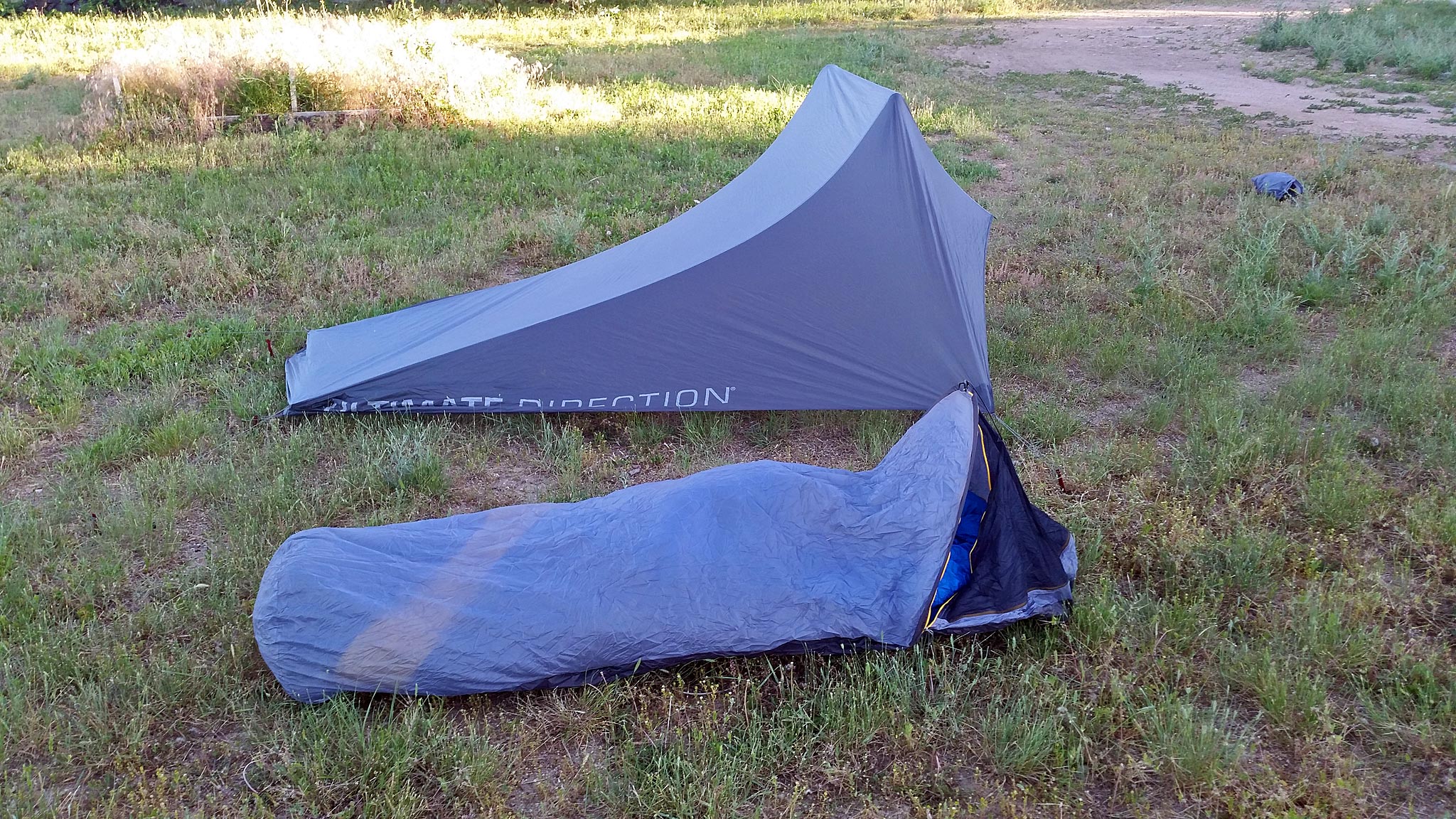
The bivy’s main job is to protect the sleeping bag and sleeping pad. My pad is not a closed-cell type, so it can develop a leak, if I’m not careful on the ground I lay under. Because of that, I do have to take small amount of time and do a bit of gardening to get rid of things like sharp branches, rocks, and pine cones, and – if I’m in a popular spot, man-made items like glass, aluminum cans, and other random trash left over (you would be surprised…).
The bottom of the bivy works much like a ground cloth, and gives a bit of a layer of protection from the above, and from moisture from say, a recent rain. If you’re going to be in a very wet area, I would most definitely supplement your own bivy with a simple ground cloth. Most likely, I’ll try to get away without bringing one, since days-on-end rain just doesn’t happen in Colorado (this sentence will jinx me, I’m sure), and the ground has surprisingly great drainage properties, as it’s not rich soil up there: it’s mostly a top layer of maybe pine needles, then sandy soil and rocks.
A bivy provides some secondary jobs: it does help in retaining heat from your body, so you’re a little warmer than sleeping without it. This adds some flexibility to the system – it you’re too warm, just sleep outside of the bivy itself. Too cold, close the zipper a bit more.
Another job it can provide is to keep bugs at bay. I’ll be using the Ultimate Direction FK Bivy. It does have a bug mesh that can be exposed or covered up with additional fabric, so if you want to keep the main zipper completely shut, you can and still get a bit of ventilation. For the most part, Colorado just doesn’t have a huge bug problem, especially up high, but it’s nice to know I can do something about it.
The FK Bivy is also a pole-less system, but does have two structural, I guess you can call them cables that provide a little bit of volume to the bivy, without making the entire package hefty. It’s enough to keep the fabric from falling in your face, so that’s really nice.
I’ve used bivy systems in the past with no structural system – they really were a nylon bag you put on the ground. The problem then becomes well, how do you keep your face from freezing or suffocating underneath a nylon sheath? I never figured that out without a wool balaclava, or wool buff covering most of my face.
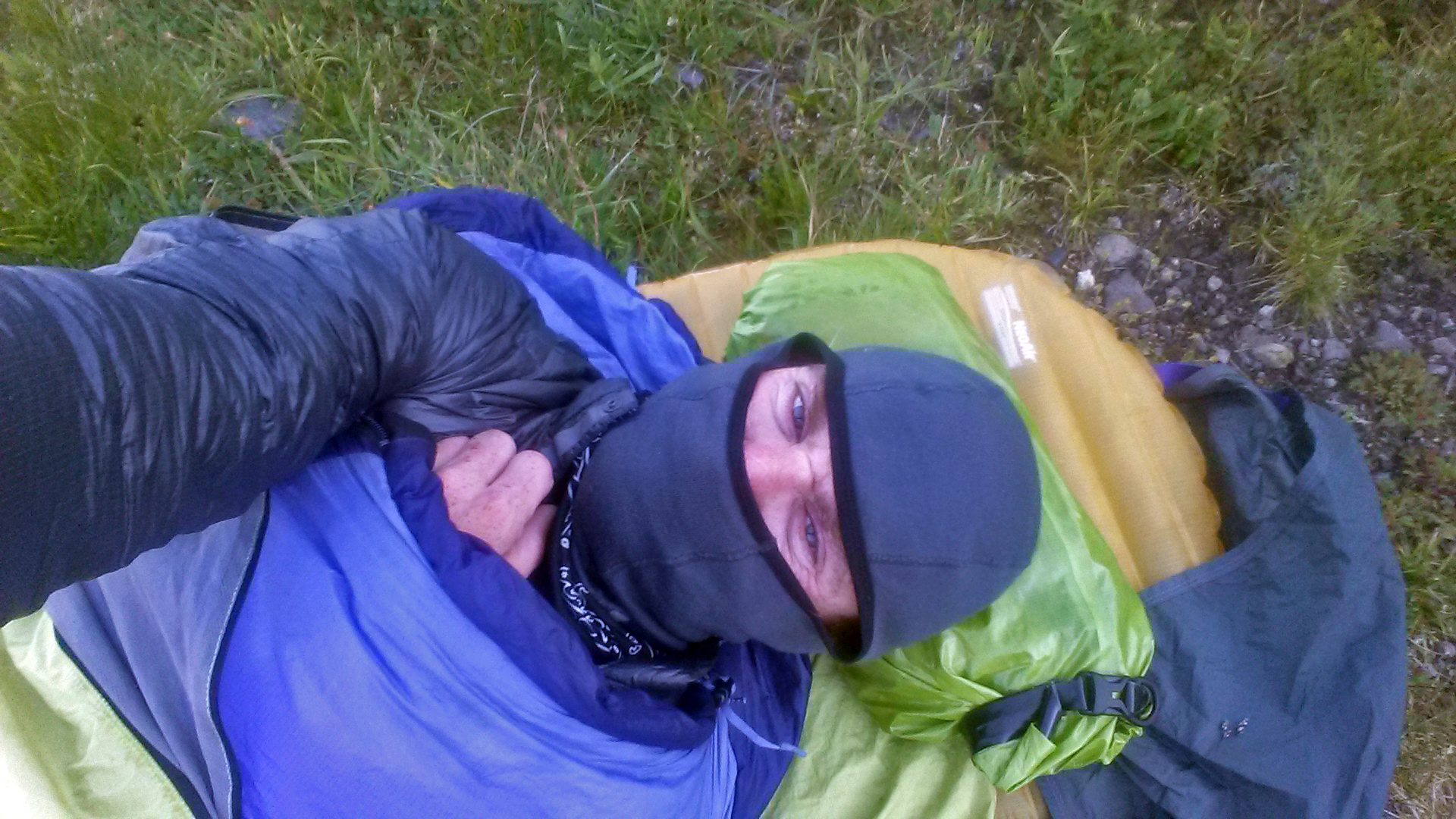
Happily, I don’t have to do that, anymore!
One characteristic of the bivy system that I use is that it is not waterproof! That’s the tarp’s job, not the bivy. Sure, there’s a little water resistance, especially the bottom fabric, but I want most of the fabric of the bivy to be breathable.
If you look at the photo above, you’ll notice the bivy’s fabric is so light, you can see the sleeping bag show right through. Throughout the night, you will perspire and it’s very, very easy to then wake up with everything soaked: you, your clothes, your sleeping bag, and your bivy. Ugh! Then, part of the morning ritual requires you to hastily dry things off enough to feel good about stuffing everything back together, while you yourself start freezing from being soaked. Yarbles to that.
Keep your sleep system breathable – if it’s too warm to sleep inside the bivy, sleep on top of it. To remind the reader, not all bivy systems should be this breathable. An alpine bivy, designed to be your only shelter high on a mountain perched on a precarious ledge in Winter conditions most likely should be pretty damn water/weather proof. But this is more of a, “tough shit!” situation: you’re either going to be miserable, or you’re going to be very near to an emergency situation, so which one do you want it to be?
Speaking of breath-ability, you’ll notice that the tarp does have one side that doesn’t reach the ground. Wind will be cut down significantly because of the tarp (and position the tarp intelligently depending on the wind direction!), but upon waking up, you shouldn’t have any moisture accumulate – maybe just a tiny bit from morning dew, but nothing a good quick shake shouldn’t peel off.
The bivy and tarp system I’m showing here were designed to work together. The constraints of how one fits under the other are pretty exact: the bivy fits underneath the tarp between the toe of the tarp and where the trekking poles stick into the ground. The portion above where your head would go you can sort of think like a tent’s vestibule/awning.
For whatever you use for a tarp make sure that no part of your bivy/sleeping bag – or really anything else touches the tarp itself. If this happens and it starts raining, any part of your body can get chilled, or change the flow of water off the tarp. It’s also easy to pop off a stake if your actively pushing against the tarp itself.
Sleeping Bag
The sleeping bag’s main job is to keep your warm while you’ve stop moving and temperatures plummet at night. I would wager that a secondary job of a sleeping bag is to keep your comfortable, as well! Sleep is not a difficult thing to acquire on a two-month marathon peak bagging trip, it’s more trying to stay awake!
For this trip, I’ll be using a really cool prototype bag being made by Sierra Designs. I don’t know if it’s coming to market in its current form, but if so, I’d be excited. I’ll try to describe some of the features it has, as I’m sure many of the other models that Sierra Designs offers share them:
First is just the temperature rating: 35 degrees is on the lighter side for a Colorado 3-season bag, but should work well with my trip, as I’m planning to supplement the bag with wearing clothes I’ll be carrying. The downside of this is that my clothes and I will ultimately stink come September. Really, last thing I’m worried about! But, it does give me flexibility for those warm, August nights where a much warmer bag is just way overboard, and I’ll just have to deal with things come mid September.
Second is the weight – and more importantly, how it’s achieved. This is an 800 fill bag – super lofty, and only weights 1lb, 7 ounces. The higher the fill number, the more loft you get, the lighter the bag will ultimately be. Crazy-high fill numbers get crazy expensive, and there’s a point of diminishing returns. Anything over 800 and well, you’re saving grams, rather than ounces. So, how do they achieve the weight, with this rating?
Distribution of loft. The majority of the fill is on the top side of the bag. The idea is that the lower fill is just going to get crushed by your body, and won’t really perform its job well, so don’t put it there! If you’re familiar with hikers that use a quilt instead of a sleeping bag, very similar idea. This bag, in my opinion, shares a lot of characteristics of a quilt.
Zipperless. There is no metal hardware on this bag! Instead, the top layer of the bag is made to wrap within itself. This, I like, since I’ll be squeezing the bag inside a bivy, which has less… maneuverability for my arms anyways, and it’s a PITA to zip, and unzip a bag. So, get rid of the zipper entirely! Sounds good to me.
So, more on the breath-ability idea. This bag doesn’t have that zipper you usually find on sleeping bags that allow you to zip the bottom of the bag, but still keep the top snug. Again, in a bivy, it’s difficult to maneuver around, but the bag does have a zipper-less baffle built in, to allow you to stick your feet out, if you get too toasty.
This bag also has a pocket to stick in your sleeping bad on the bottom, so that the two are integrated a bit better. It’s easy for a pad to slip around while you sleep and – again, when you’re in a bivy, it’s somewhat of a chore to try to get things in order without getting out. With this pocket, I won’t need to.
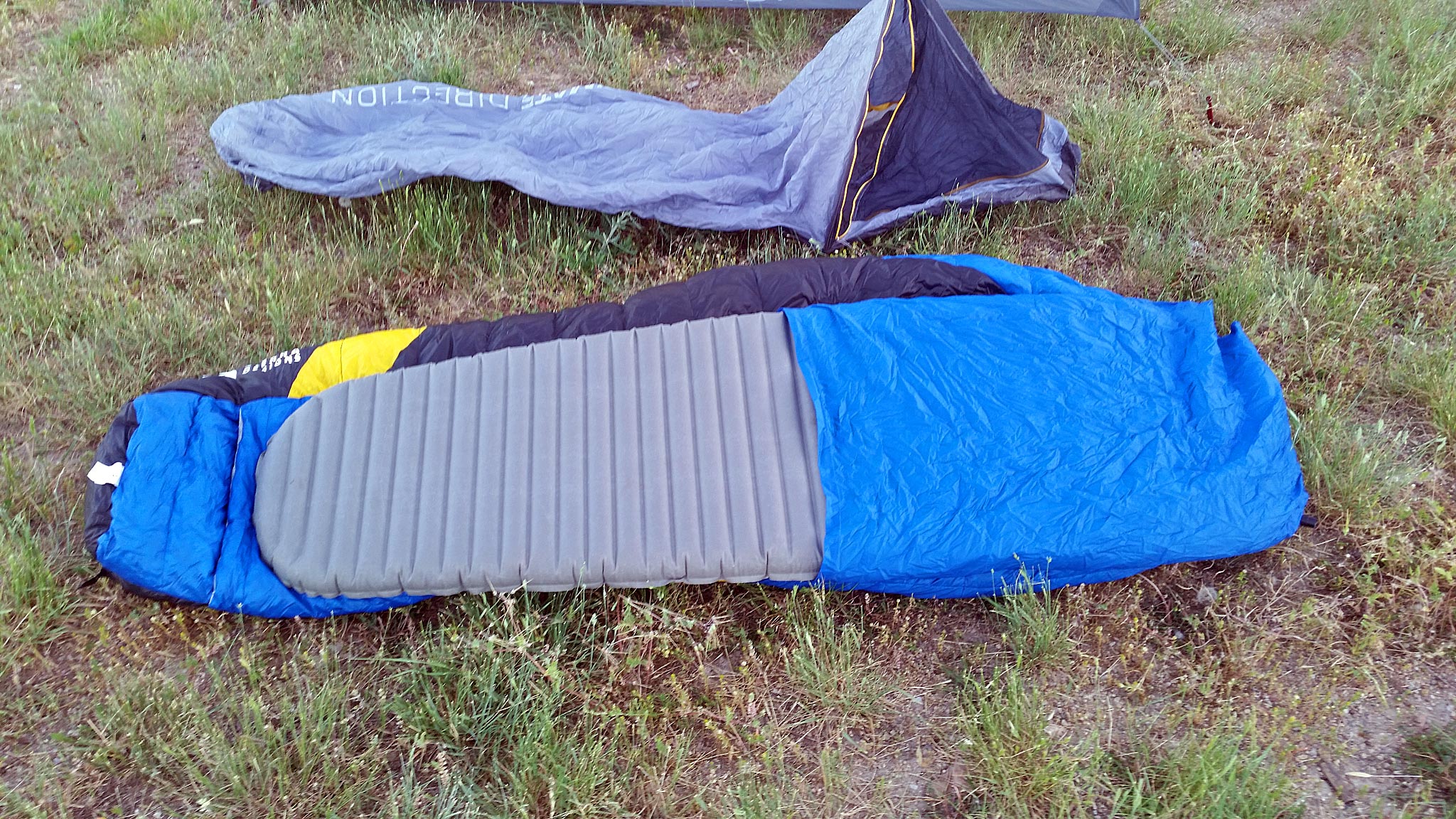
Finally, the outer material has a DWR coating, and the down is Sierra Designs DriDown, so even if this bag gets a little moisture, it should retain its loft and temperature rating well. This bag is a pretty tricked out part of my kit, and I’ve actually have been selling off my stable of sleeping bags on both sides of the temperature rating – it seems like it’ll fill a wide range of conditions!
Sometimes, I do bring along a sleeping bag liner. These can be used to add a bit to the temperature rating, or keep the bag cleaner – sleeping bags aren’t cheap and they are a pain to clean. I’ll most likely go without, since even though they can add to the temperature rating, they don’t do so without a substantial amount of weight and volume for what they seem to add.
And again: a bag and a bivy: fine, but add yet another layer to try to get into (under a tarp, no less), and it becomes somewhat annoying to get in and out when you’re stressed and tired. It’s one more thing to pack, etc. I also won’t ever be in this bag without clothes on, so the oil from my body won’t really contact the bag all that much, and I’ve already come to terms with getting the bag professionally cleaned once I’m done with my tour.
- Update 10/18.17: Read Andrew Skurka’s review of the Sierra Designs Cloud 35.
Sleeping Pad
The job of the sleeping pad is to insulate you from the cold ground, as well as to reflect heat back up from your body.
Do not skimp on your sleeping pad.
If given the choice of a sleeping pad, and sleeping bag for an overnight trip, I would always chose the sleeping pad. Pound for pound, it’ll keep you warmer. I’ll be using a Therm-a-Rest NeoAir XTherm 3/4 length. It’s light (enough), tough (enough) and has a crazy R-Value of 5.7 (higher the R-Value, warmer it is!), and is rated for Winter use. Using a sleeping bad like this makes skimping on your sleeping bag a little more realistic. There’s little reason to use a full-length pad – stick something underneath your feet if you need to (like the pack you’ve brought) and you’ll be fine.
One thing it’s not is cheap, but it was a investment I made years ago, and I couldn’t be happier.
If you have less of a budget, maybe go for a good closed cell pad. You’ll lose majorly with pack-ability, but you’ll keep at least some of the R-Value.
I keep my pad inside my bivy sack, which does the job of a ground cloth, and the pad fits into the pocket attached the bottom of my sleeping bag – nice integration!
So those are the four main parts of my sleep system, but there is another part to this all: where do you keep everything packed up? Ah, the mighty stuff sack:
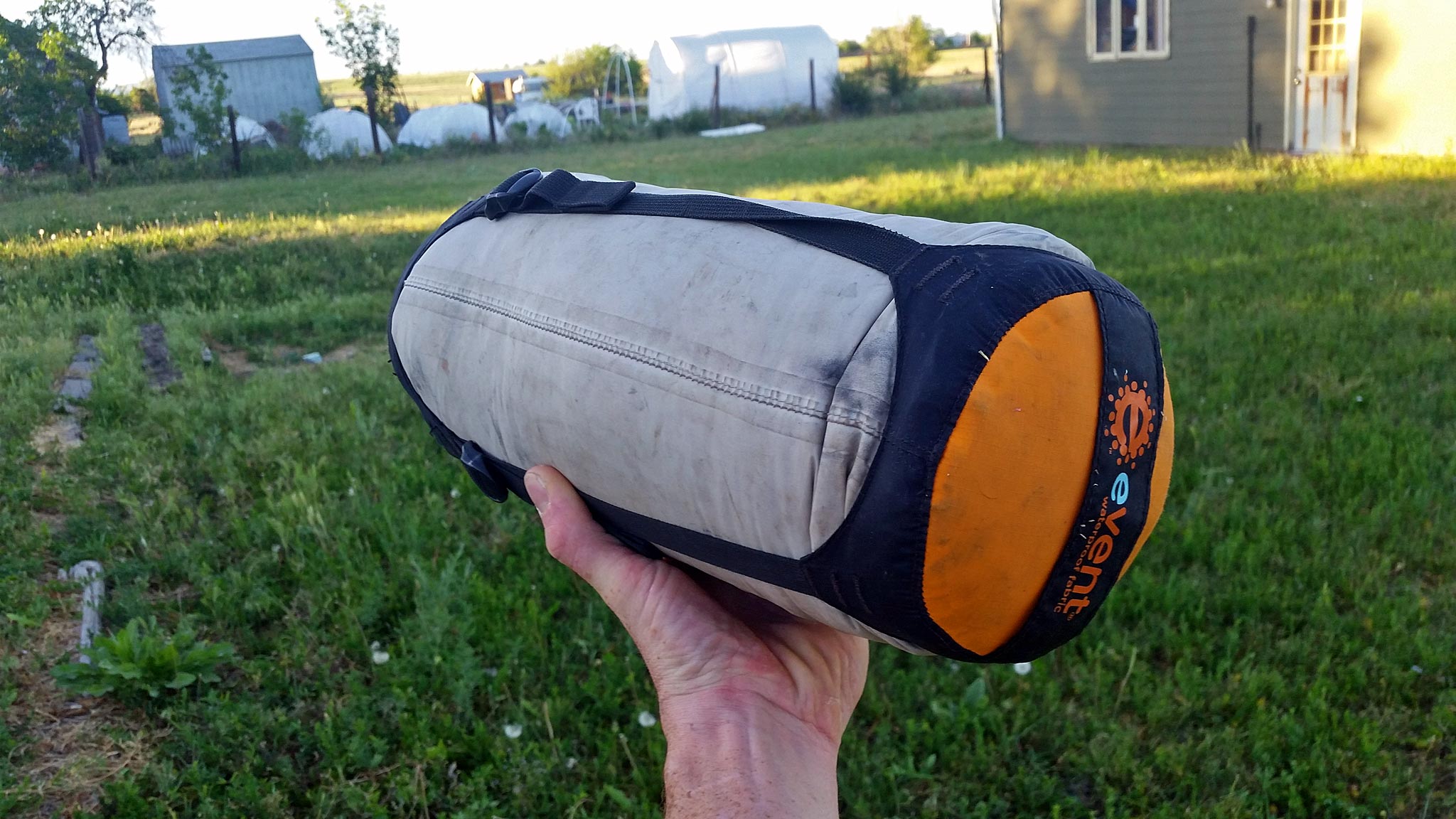
This is the Sea To Summit eVent Compression Dry Sack. I like this thing a whole lot. It’s waterproof, but the butt end of the thing allows air to escape, so you can really squeeze the ever living crap outta the thing, to get things way compressed. The tarp/bivy/bag and pad I’ve just described above (sans bivy cables and stakes, which you don’t want to compress in here!) fits inside the 6L, XS model.
There are things I don’t like about it; namely, the fabric has no give, and it’s certainly not anything similar to a rip stop-like material, so if you get a cut in it, it’s toast – it’ll just shred itself completely. I’ve abused mine pretty heavily by lashing it to the outside of my bike, but I wouldn’t suggest this for any long term use, and I won’t do that for this trip.
Instead, I’ll be putting this whole payload inside a Revelate Designs Sweetroll. As luck would have it, the diameter of the XS dry sack, and the diameter of the medium Sweetroll are just about the same, so with a bit of spit and luck, you can slide this dry sack inside the Sweetroll, and have room to spare on either end!
I can then take the whole thing out to set up, or just plop into my Fastpack 35, and away I go! Since there’s tons of extra room in the Sweetroll, it also makes sense to not compress the sleeping bag quite so hardcore, as extended periods of time compressed so mightily will cause damage to the bag itself, and it won’t loft up so willingly. Plus, the dry sack can get damaged by abuse. So, I won’t – the Sweetroll itself is also waterproof and made of much tougher material.
But, I won’t just be carrying my sleep system on my bike. I’m also planning to do extended Fastpack tours within my full tour, so I need to get the sleep system to fit into my Fastpack 35. And, guess what the length of the drysack is just about the same as?
Go on, guess:
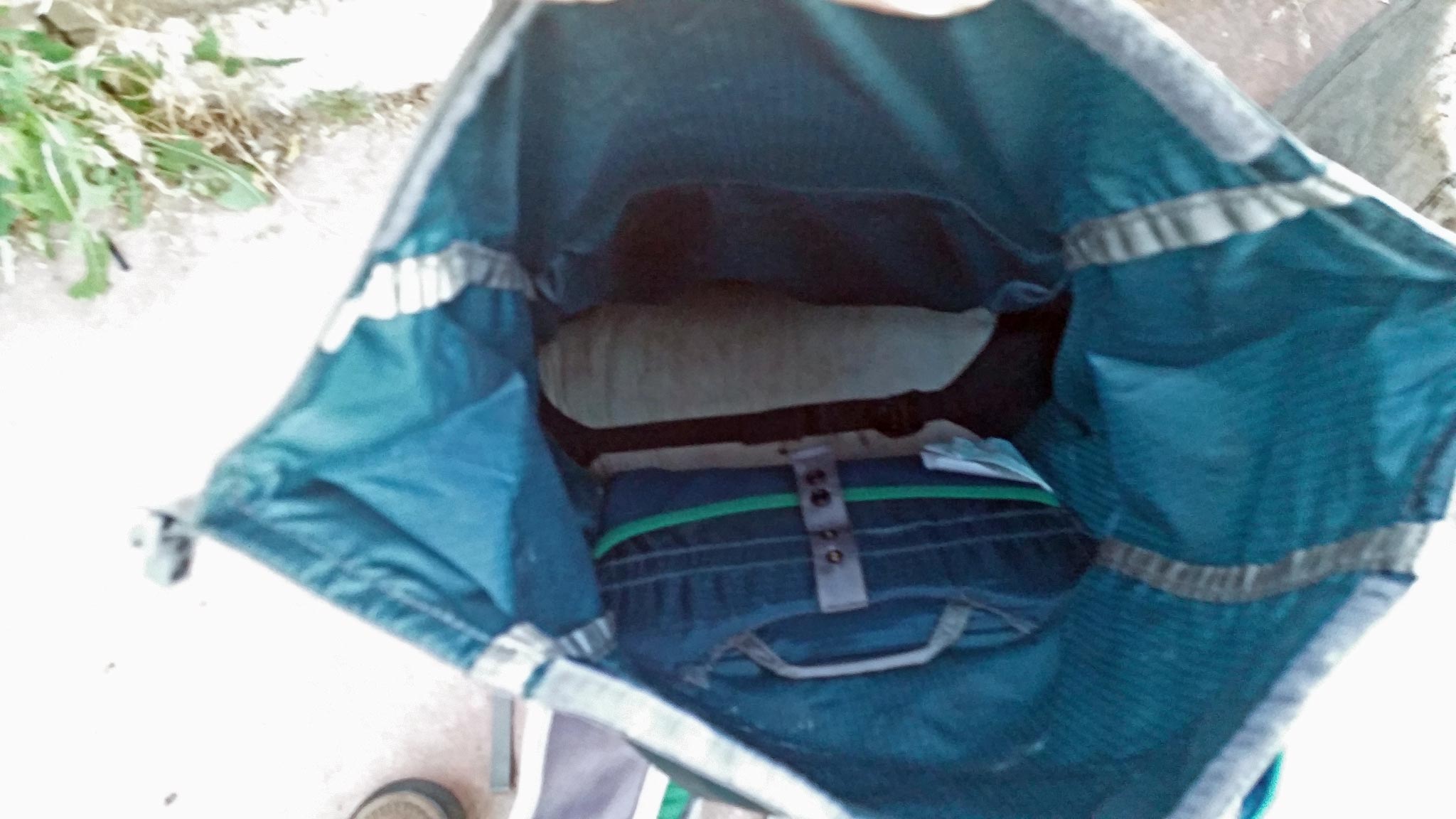
Can you see it, all the way down there? That’s right, the length of the drysack is the same as the width of the Fastpack 35. I can smoosh it down there, and forget about it, until I need to pass out for a few hours. The rest of the pack’s volume can be used for whatever else I need.
Here’s another view of the Fastpack 35:
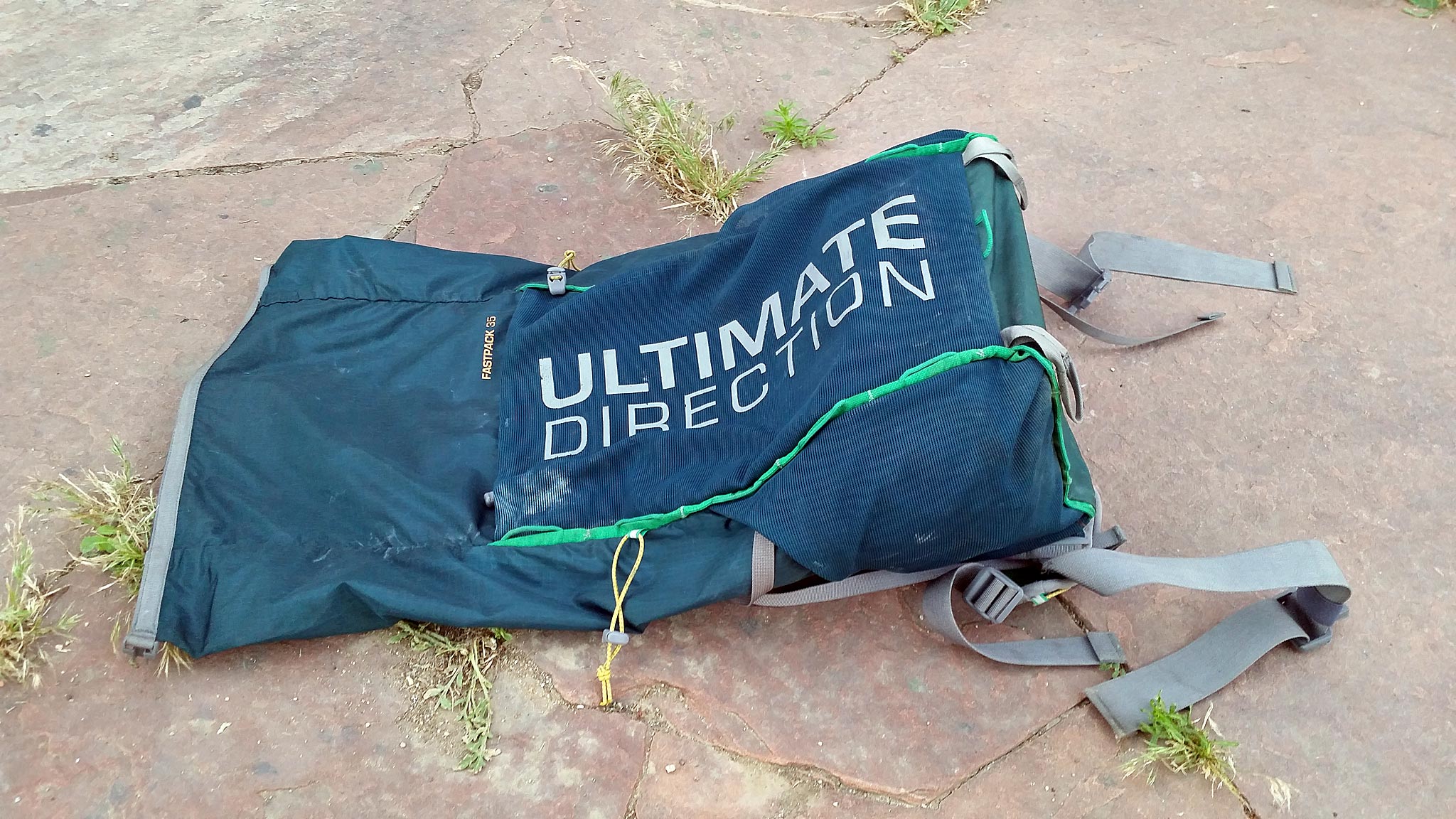
The sleep system really doesn’t take up that much room – from right to left, it takes up the very bottom of the pack, and goes about to the, “I” of, “Direction”. That’s a TON of room to fit everything else I need, most importantly, 5+ days of food.
For my 14er tour, I only brought a Peter Bakwin Adventure Vest 2.0, which did not have room for a sleep system of any heft:
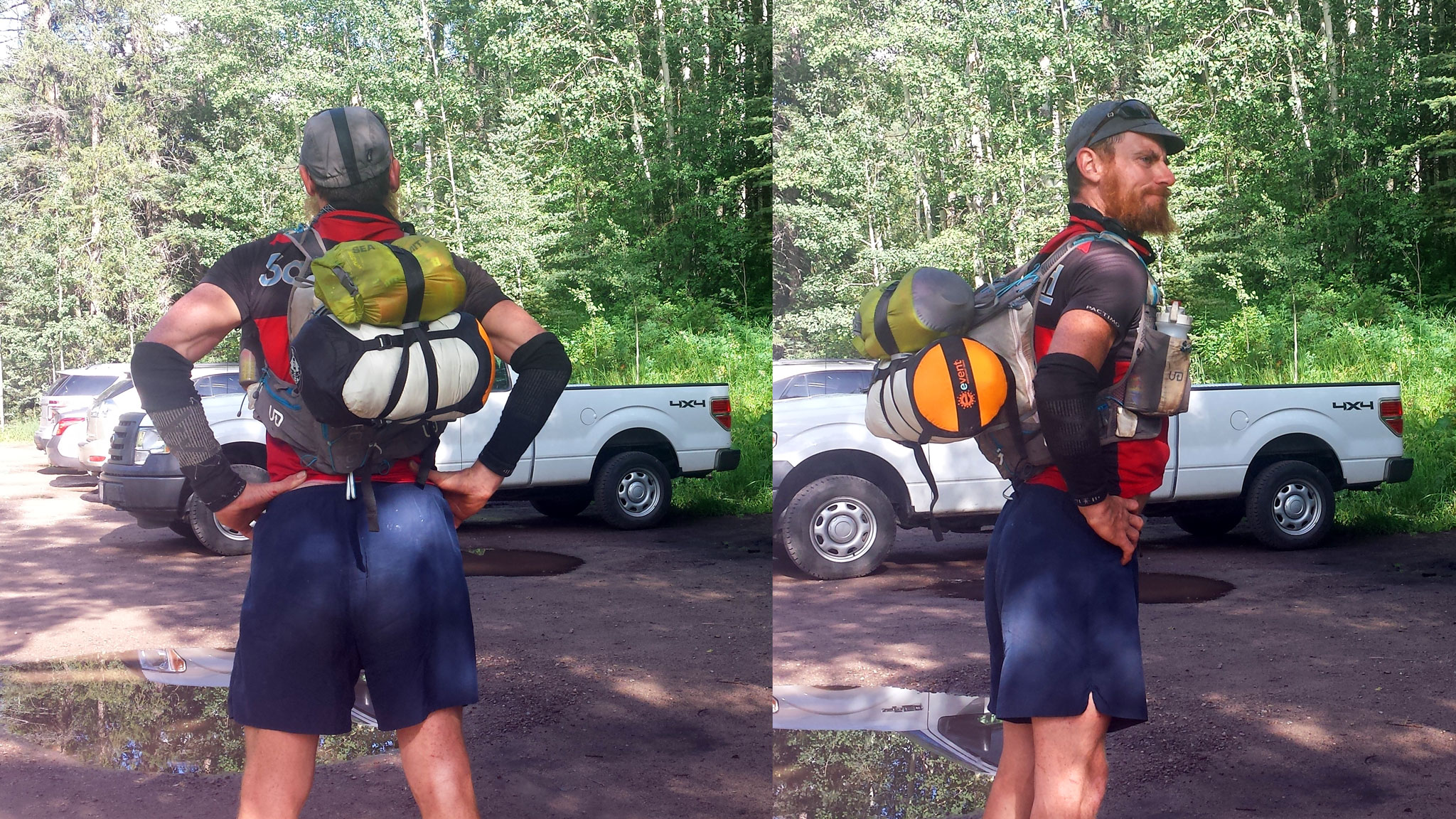
…so I tied one down (and my food!) to the outside with straps! This was sort of hilarious to pull off, but I’m not sure if it would work for 4 to 5 days! I also only did this twice: For Capitol/Snowmass and The Chicago Basin. I don’t remember it being all that comfortable!
Mix and Match
There can be a lot to putting the sleep system together, just to pack it all up in a few hours. Most likely, I won’t find the need to always put the tarp up, which is the most time consuming part of this all. If the skies are clear, I’ll risk just using the tarp as an extra ground cloth. If the weather turns while I’m snoozing, it’s not impossible to get things up and running in a few minutes, then go back to sleep.
If I decide on an extended ridge run of many hours, I may take the tarp just as an emergency shelter I can bring along, and wrap myself up in, as I watch a hail storm pass overhead.
As I mentioned before, if it’s a hot night, you won’t need to even sleep inside the bivvy – sleep outside of it, and use it as a ground cloth. If I’m sleeping more than 90 minutes, I’ll probably always blow up the pad, even though that seems a pain. This particular pad I’ve picked out is a lot easier to blow up and get the air out of afterwards – it’s not a self-inflating model, which I prefer.
How It All Adds Up
Final weight of the whole system, including compression sack is a bit over what four beers weigh. Not bad!
So that it’s, that’s my rundown of the sleep system I’m bringing along, as well as some critical points on why I’m bringing each piece along. Have any questions on anything I didn’t cover?
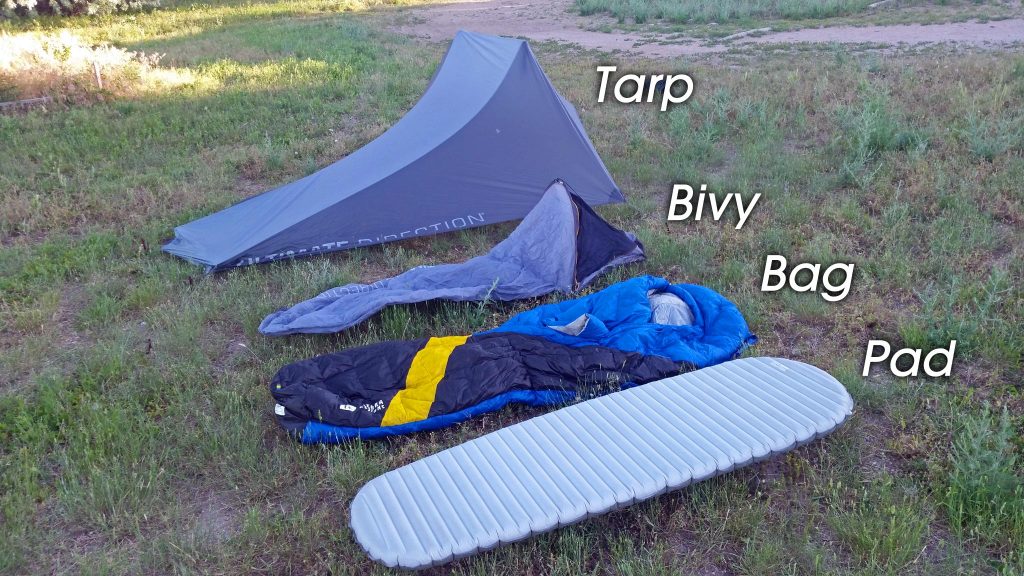
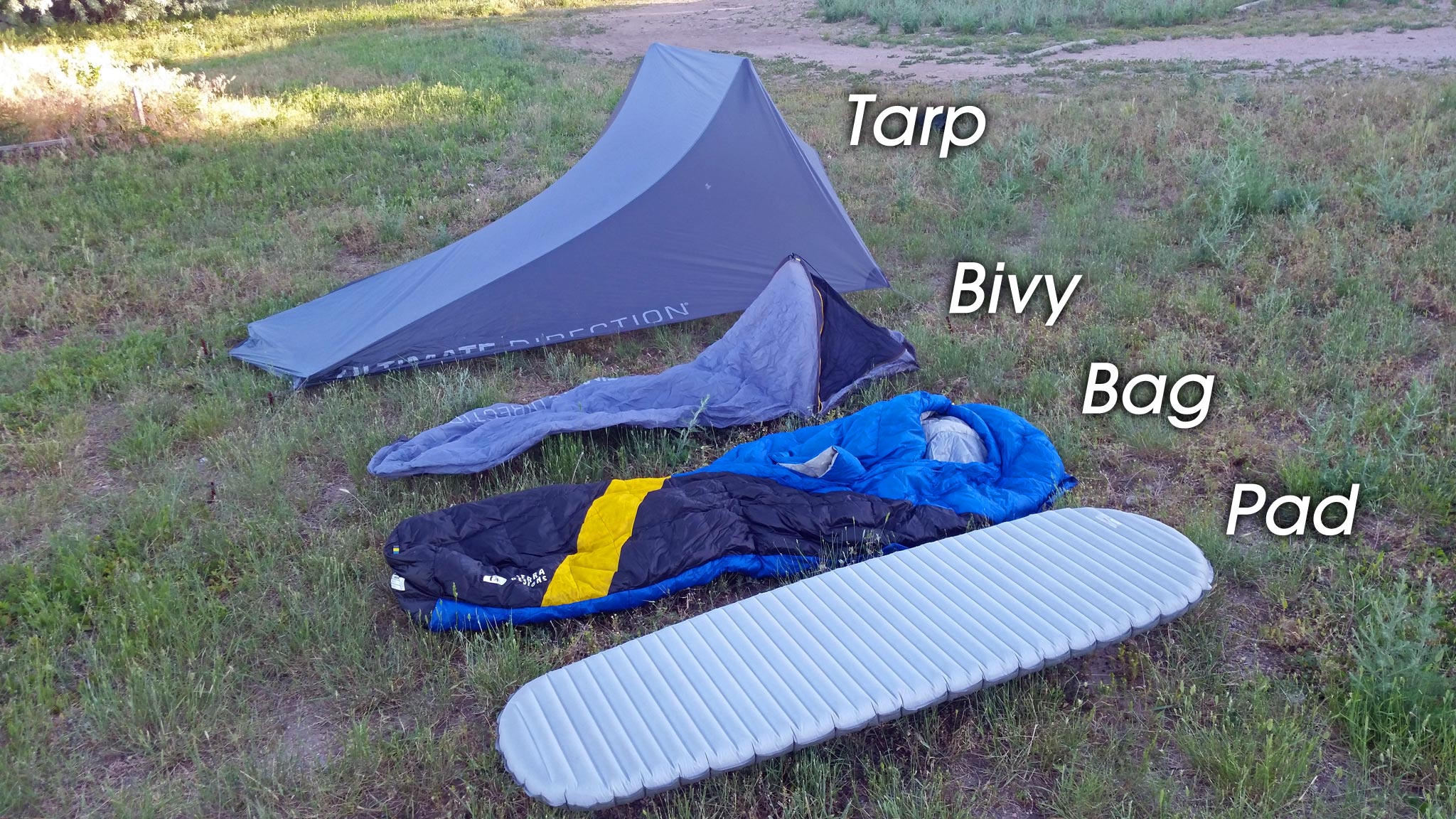
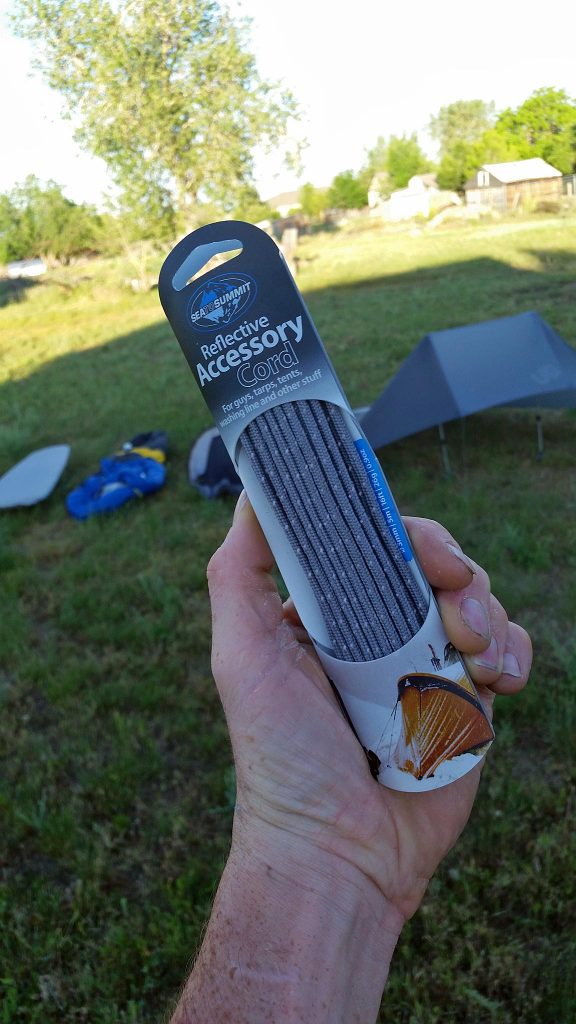
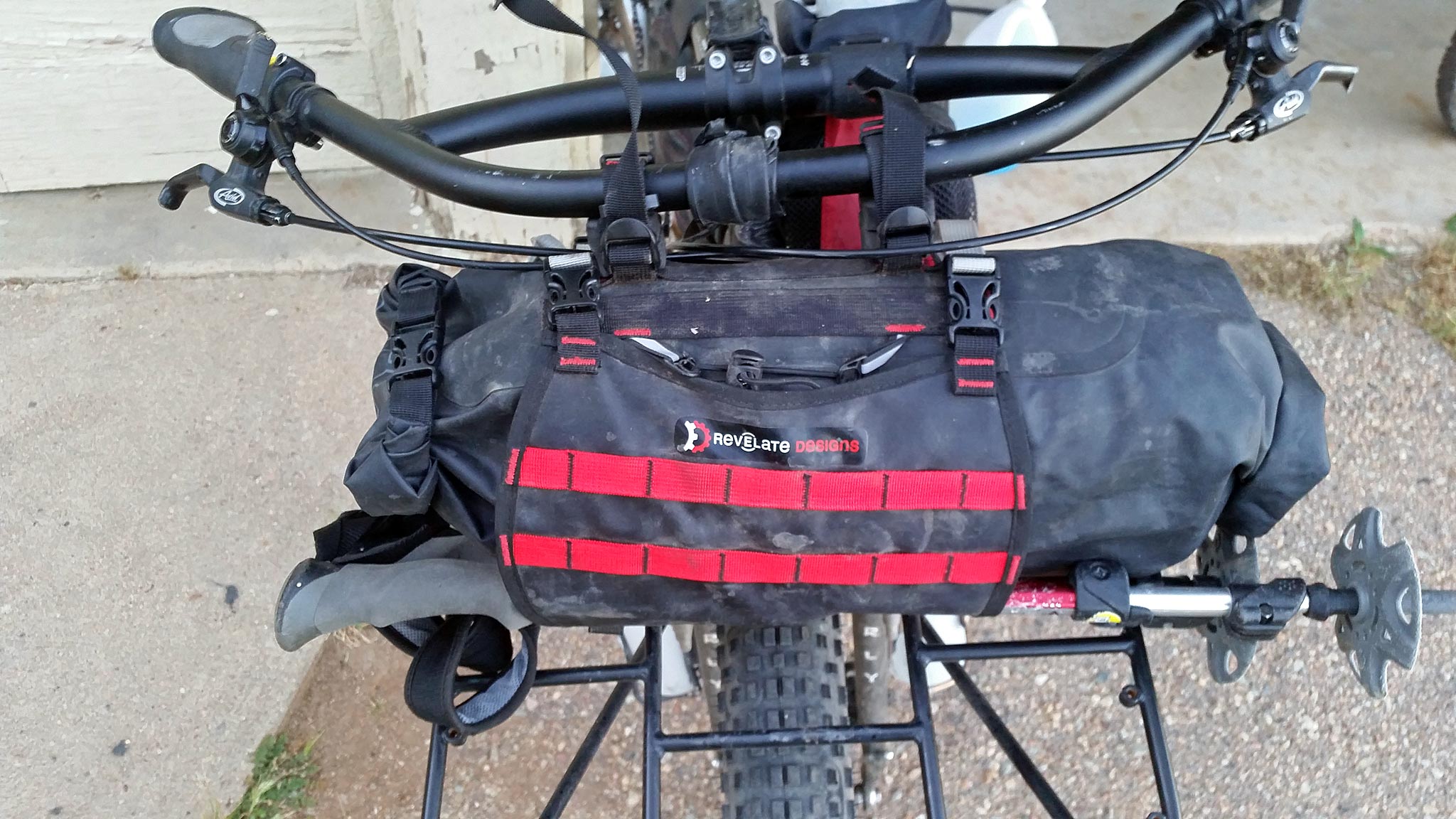

[…] My Sleep System for the Tour of the Highest Hundred […]
I went to the Ultimate Direction website as linked but couldn’t find a listing for the bivy or the tarp?
Both the FK Tarp and FK Bivy should be available in a few weeks – contact Ultimate Direction directly (https://ultimatedirection.com/contact-us/) they may have some more specific info.
Now available!
https://ultimatedirection.com/shelters/
Thanks for the awesome guide, Justiner! Very helpful in building my own setup…
[…] That’s why I designed this enchainment as a fastpack and brought along a sleep kit that would allow me to weather through almost anything. The sleep kit, three days of food, clothes, and other gear all fit in my Ultimate Direction Fastpack 35 which was comfortable enough to take on the technical/heinous pitches – like the Little Bear/Blanca traverse, which isn’t normally done as part of a backpacking trip! I break down my sleep system in a separate post. […]
[…] Added up, it weighed less than 4 lbs. I fit that all in a Sea to Summit XS eVent compression dry sack. I could fit that snugly into my 35 liter pack for long fastpacks, or into a Revelate Designs Sweetroll quickly. I have a big writeup about the sleep system gear here. […]